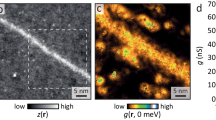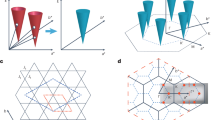Abstract
The recent discovery1–3 of high-temperature superconductivity in the Y(La}–Ba–Cu–O system has generated intense experimental and theoretical activity. On the theoretical side, it has revived the discussion of different modes of pairing in solids4,5. Here we report some important features of the low-field electron spin resonance (ESR) spectrum in the superconducting phase of YBa2Cu3O7–x, giving evidence for the dimerization of electrons on copper pairs. An intense low-field resonance appears below the critical temperature, Tc, and exhibits unresolved hyperfine structure at temperatures below 70 K. The resonance field was found to be dependent on both temperature and microwave frequency. These are well-established features characteristic of copper pairs formed due to an exchange interaction. It appears that the individual spins responsible for superconductivity are formed and dimerized only at Tc, with their intensity sharply increasing below Tc. This observation appears to be a pointer towards the possibility of the disproportionation 2Cu3+ → Cu2+ + Cu4+ in adjacent octahedra, facilitated by coupling to local eg vibrations in the superconducting phase.
This is a preview of subscription content, access via your institution
Access options
Subscribe to this journal
Receive 51 print issues and online access
$199.00 per year
only $3.90 per issue
Buy this article
- Purchase on Springer Link
- Instant access to full article PDF
Prices may be subject to local taxes which are calculated during checkout
Similar content being viewed by others
References
1. Bednorz, J. G. & Mullet, K. A. Z. Phys. B64, 189 (1986). 2. Wu, M. K. et al. Phys. Rev. Lett. 58, 908-911 (1987). 3. Gopalakrishnan, I. K.., Yakhmi, J. V. & lyer, R. M. Nature 327, 604-605 (1987). 4. Anderson, P. W. Science 235, 1196-1198 (1987). 5. Emery, V. J. Phys. Rev. Lett. 58, 2794-2797 (1987). 6. David, W. I. F. et al. Nature 327, 310-312 (1987). 7. Bhatt, S. V., Ganguly, P. & Rao, C. N. R. Pramana-J. Phys. 28, L425-427 (1987). 8. Johnston, D. C. et al. Pap. presented at Am. chem. Soc. Meet. New Orleans (31 August-4 September, 1987). 9. Durny, R. et al. Phys. Rev. B36, 2361-2363 (1987). 10. Blazey, K. W. et al. Phys. Rev. (in the press). 11. Bleaney, B. & Bowers, K. D. Proc. R. Soc. A214, 451-465 (1952). 12. Abe, H. J. phys. Soc. Japan 13, 987-997 (1958). 13. Abragam, A. & Bleaney, B. Electron Paramagnetic Resonance of Transition Ions (Clarendon, Oxford, 1970). 14. Wrobel, J. M., Wang, S., Gygax, S., dayman, B. P. & Peterson, L. K. Phys. Rev. B36, 2368-2370 (1987).
Author information
Authors and Affiliations
Rights and permissions
About this article
Cite this article
Sastry, M., Dalvi, A., Babu, Y. et al. Possible role of Cu2+–Cu4+ pairs in the superconductivity of YBa2Cu3O7–x from electron spin resonance observations. Nature 330, 49–51 (1987). https://doi.org/10.1038/330049a0
Received:
Accepted:
Issue Date:
DOI: https://doi.org/10.1038/330049a0
This article is cited by
-
Microwave absorption investigation on the formation of YBa2Cu3O7−σ by a binary metal oxide route involving interaction of BaCuO2 and Y2Cu2O5
Applied Magnetic Resonance (1990)
-
EPR study of polycrystalline superconductors with YBa2Cu3O7 structure
Journal of Low Temperature Physics (1989)
-
Superconductivity and microwave absorption
Nature (1988)
Comments
By submitting a comment you agree to abide by our Terms and Community Guidelines. If you find something abusive or that does not comply with our terms or guidelines please flag it as inappropriate.



